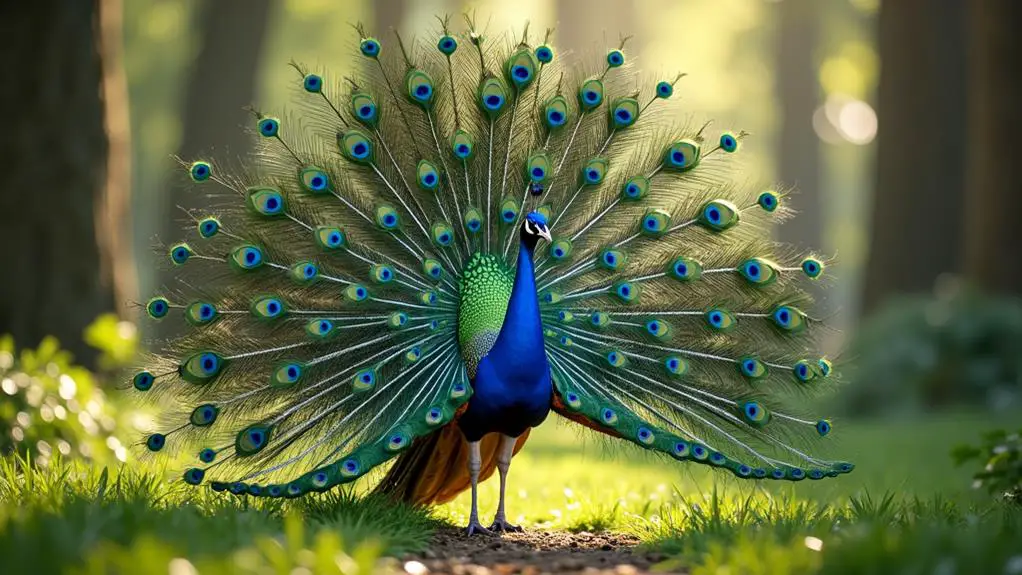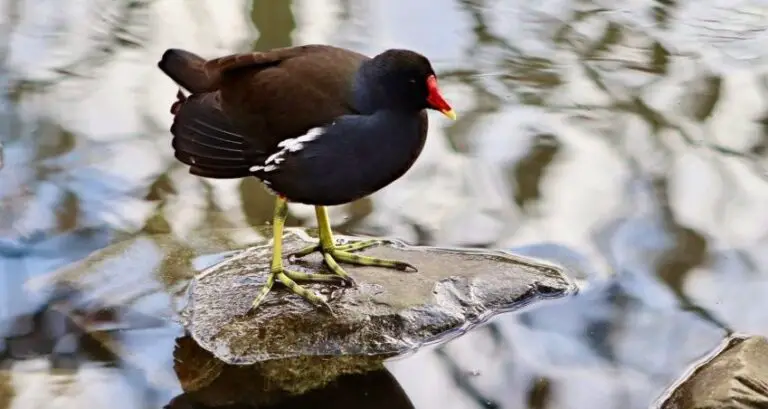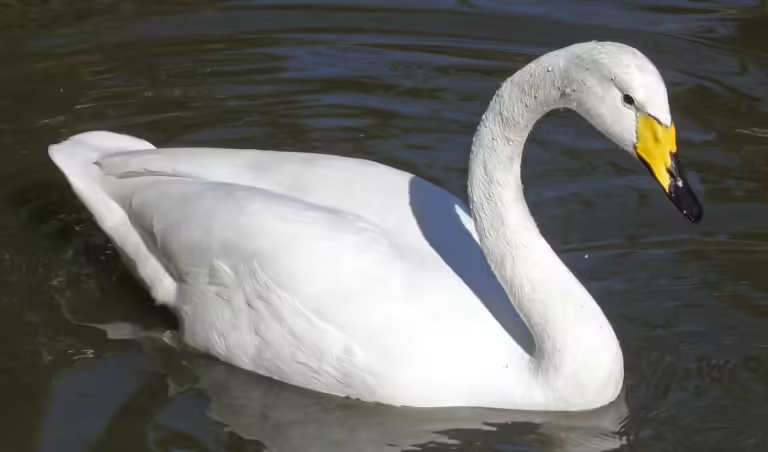You might be surprised to know that over 60% of peacock sightings involve males displaying their extravagant plumage. But what triggers this behavior in the first place? Why Peacocks Spread Their Feathers? As you observe these stunning displays, it becomes clear that there’s more to it than just aesthetics. It seems that the peacock’s impressive spread of feathers serves a purpose that goes beyond mere showmanship. By examining their behavior, you’ll discover that spreading their feathers is crucial to a peacock’s survival, social standing, and even its chances of finding a mate – but what exactly drives this complex behavior?
Key Takeaways
- Peacocks spread their feathers to attract mates, showcasing their genetic quality, health, and fitness through their plumage and displays.
- The display serves as a warning to potential predators, signaling the peacock’s size, strength, and readiness to defend itself.
- Dominant males spread their feathers to reinforce social status and remind other males of their position within the hierarchy.
- Spreading feathers is an instinctual behavior, deeply rooted in the peacock’s genetic predisposition, shaped over thousands of years through natural selection.
- The display is used for territorial defense, protecting valuable resources such as food, water, and shelter, which are essential for the peacock’s survival.
Courtship and Mating Rituals
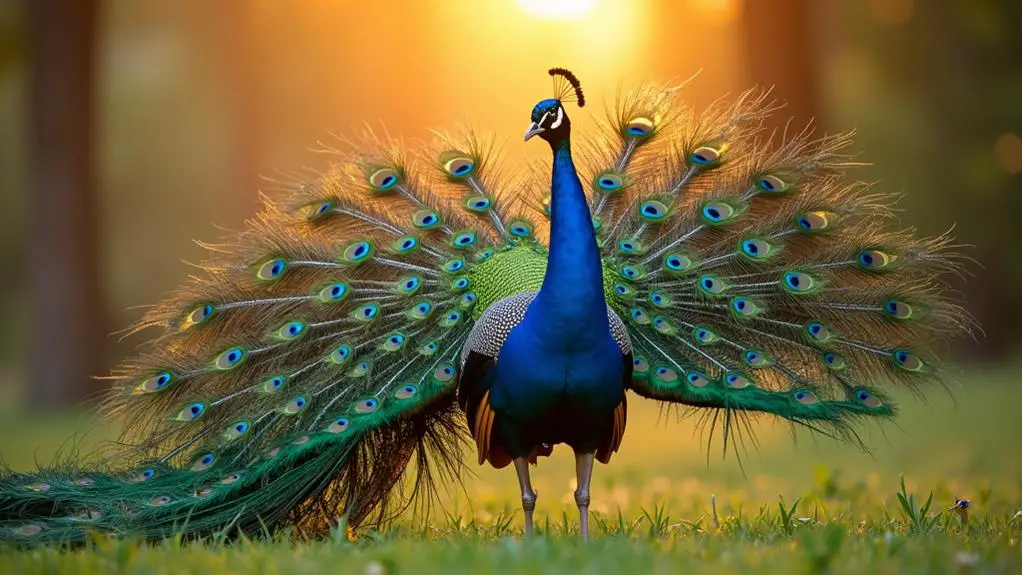
When you observe a peacock’s behavior during the breeding season, you’ll notice it’s not just about spreading its vibrant feathers – it’s an intricate courtship and mating ritual.
This complex process involves mate selection, where the peacock showcases its plumage, calls, and displays to attract a female.
The peahen, in turn, assesses the peacock’s suitability as a mate based on the quality of its display.
During courtship, the peacock’s displays serve as a form of communication, conveying information about its genetic quality, health, and fitness.
The peahen evaluates these cues to make an informed decision about mate selection.
Once a pair forms, they engage in pair bonding behaviors, such as preening and vocalizations, which strengthen their bond and facilitate mating.
The peacock’s courtship displays also play a crucial role in stimulating the peahen’s reproductive cycle.
The visual and auditory cues provided by the peacock’s displays trigger hormonal changes in the peahen, preparing her for mating.
Territorial Display and Defense
When you observe a peacock’s behavior, you’ll notice that its territorial display and defense mechanisms are intricately linked to its courtship and mating rituals.
By spreading its vibrant feathers, the peacock effectively defends its territory from rival males, while also attracting a potential mate.
This display also serves as a warning to potential predators, signaling the peacock’s size, strength, and readiness to defend itself.
Defending Their Territory
Peacocks primarily defend their territory through a unique display of plumage and vocalizations.
When you think of a peacock’s territorial defense, imagine a boundary patrol where they vigilantly guard their area against potential intruders.
As the peacock spreads its feathers, it’s not just a visual display; it’s also an auditory warning, with loud calls that alert other peacocks to stay away.
This territorial display serves to protect valuable resources, such as food, water, and shelter, which are essential for the peacock’s survival.
Attracting a Mate
As a male peacock performs his extravagant display of feathers, a prime motivator behind this behavior is to attract a female. You may have noticed that male peacocks have vibrant plumage, which they use to create fancy displays. These displays are crucial in attracting a mate, as they showcase the male’s health, strength, and genetic quality.
| Display Component | Description | Importance |
|---|---|---|
| Eye Spots | Bright, colorful spots on the feathers | Signal genetic quality and health |
| Train Length | Length of the feathers in the display | Indicates strength and vigor |
| Rattle Call | Loud, rattling sound made during display | Attracts females and signals courtship |
When a male peacock performs his display, he is signaling to females that he is a suitable mate. The quality of his display determines his attractiveness to females, who will often choose the male with the most impressive display. By spreading their feathers and performing intricate courtship displays, male peacocks are able to showcase their suitability as mates and increase their chances of reproducing.
Warning Off Predators
Male peacocks‘ extravagant displays of feathers serve another crucial purpose beyond attracting a mate: warning off potential predators and defending their territory.
When you observe a peacock spreading its feathers, you’re witnessing a complex behavior that’s both a warning signal and a threat display. This behavior is particularly effective against predators that rely on stealth and surprise, as the sudden appearance of the peacock’s colorful plumage can trigger a startle reaction.
The fear response elicited in predators by the peacock’s display is immediate and intense. By spreading their feathers, peacocks appear larger and more threatening, making potential predators think twice before attacking.
This territorial display also serves to advertise the peacock’s presence to other birds, warning them to stay away from its territory.
Threat Response and Warning
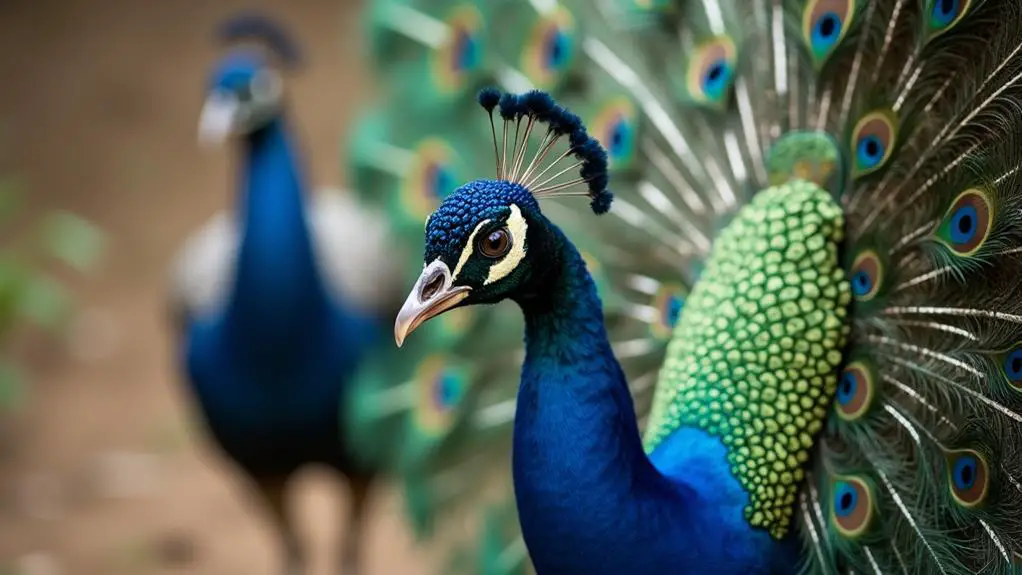
When you observe a peacock’s behavior in response to a threat, you’ll notice it displays specific warning signs to alert other peacocks in the area.
These predator warning signs are crucial for the birds’ survival, as they allow others to take evasive action and protect themselves.
In addition to warning other peacocks, the threatened bird will often intensify its territorial display, signaling to potential predators that it’s prepared to defend itself.
Predator Warning Signs
Peacocks spread their vibrant feathers in response to potential threats, serving as a warning to predators that they’re prepared to defend themselves.
By displaying their brightly colored plumage, they’re signaling to potential predators that they’re strong, healthy, and ready to fight. You’re essentially seeing the peacock’s fear signals being converted into a warning to the predator, signaling them to stay away.
When a peacock senses a threat, it will spread its feathers in a specific pattern, creating a circular display of colors and patterns.
This display serves as a warning flag, signaling to the predator that the peacock is aware of its presence and is prepared to defend itself. The display also serves to make the peacock appear larger, which can be intimidating to potential predators.
By spreading its feathers, the peacock is using a visual signal to communicate its intentions to the predator, effectively saying “stay away” or “I’m not an easy target.”
This threat response is a common behavior among peacocks, and it plays a crucial role in their defense strategy.
Territorial Display Response
During its impressive threat displays, it becomes evident that territorial dominance and boundaries play an important part in peacocks’ natural behaviors, manifesting beyond fear response tactics used when under a specific type threat.
As a territorial bird, you’ll notice that peacocks use their vibrant plumage to signal dominance and establish boundaries, particularly during mating seasons.
The territorial display response serves multiple purposes, including deterring potential competitors and warning neighboring peacocks to respect their boundaries.
You’ll see that peacocks spread their feathers when competing for food, signaling to other birds that they’re not willing to back down.
This behavior is especially pronounced during food competition, where peacocks must assert their dominance to secure resources.
In the context of neighbor boundaries, peacocks use their displays to maintain a safe distance between themselves and other birds.
By spreading their feathers, they signal to potential intruders that they’re not welcome in their territory.
This warning serves as a deterrent, preventing conflicts and allowing peacocks to coexist peacefully.
Social Hierarchy and Dominance
A dominant male’s vibrant plumage serves as a visual cue, signaling his status within the social hierarchy.
You’ll notice that when a peacock spreads its feathers, it’s often in the presence of other males, as it’s a way to assert dominance and establish a clear social order. In the context of flock dynamics, this display of plumage helps maintain social status, with dominant males typically having priority access to food, water, and other resources.
When a subordinate male encounters a dominant male, it will often retreat or display submissive behavior to avoid conflict.
This helps maintain social stability within the flock, as dominant males can focus on defending their territory and resources rather than constantly competing with other males. By spreading their feathers, dominant males reinforce their social status, reminding other males of their position within the hierarchy.
This visual cue is essential for maintaining order within the flock, allowing dominant males to lead and protect their territory effectively.
Attracting a Mate Successfully
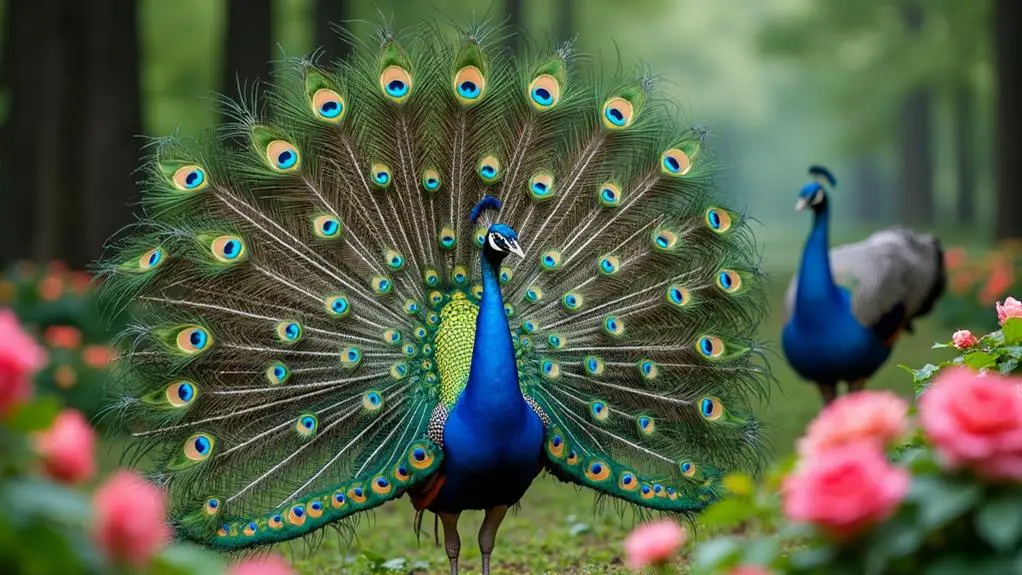
In the pursuit of attracting a mate, male peacocks rely heavily on their vibrant plumage, using it as a visual cue to signal their suitability as a partner.
This display of colorful feathers plays a crucial role in mate selection, as it showcases the male’s overall health, strength, and genetic quality.
When it comes to attracting a mate successfully, several key factors come into play:
- Genetic diversity: A male peacock’s plumage can indicate his genetic diversity, making him a more attractive partner for females seeking to produce healthy offspring.
- Mating season: Male peacocks typically spread their feathers during mating season, increasing their chances of attracting a mate.
- Courtship displays: The vibrant plumage is often accompanied by elaborate courtship displays, which help to showcase the male’s suitability as a partner.
- Female choice: Female peacocks play a significant role in mate selection, choosing the male with the most impressive plumage and courtship display.
- Perfect partner: By spreading their feathers, male peacocks aim to demonstrate their suitability as the perfect partner, increasing their chances of successful mating.
Visual Communication and Signals
The display of vibrant plumage by male peacocks serves as a prime example of visual communication and signals in the natural world. As you observe a peacock’s courtship display, you’ll notice that it’s not just about the stunning feathers – it’s also about the way the bird uses its body to convey information. Facial expressions and body language play a crucial role in this process.
| Signal | Description | Function |
|---|---|---|
| Eye Spots | Brightly colored spots on the feathers, resembling eyes | Deter predators, attract mates |
| Feather Raising | Peacock raises its feathers to create a fan-like shape | Display dominance, attract mates |
| Posturing | Peacock stands upright, spreading its feathers and tail | Assert dominance, signal aggression |
When you watch a peacock display its plumage, you’re witnessing a complex form of nonverbal communication. The bird is using a combination of visual cues to convey information about its identity, status, and intentions. By understanding these signals, you can gain a deeper appreciation for the intricate social dynamics at play in the world of peacocks.
Instinctual Behavior and Evolution
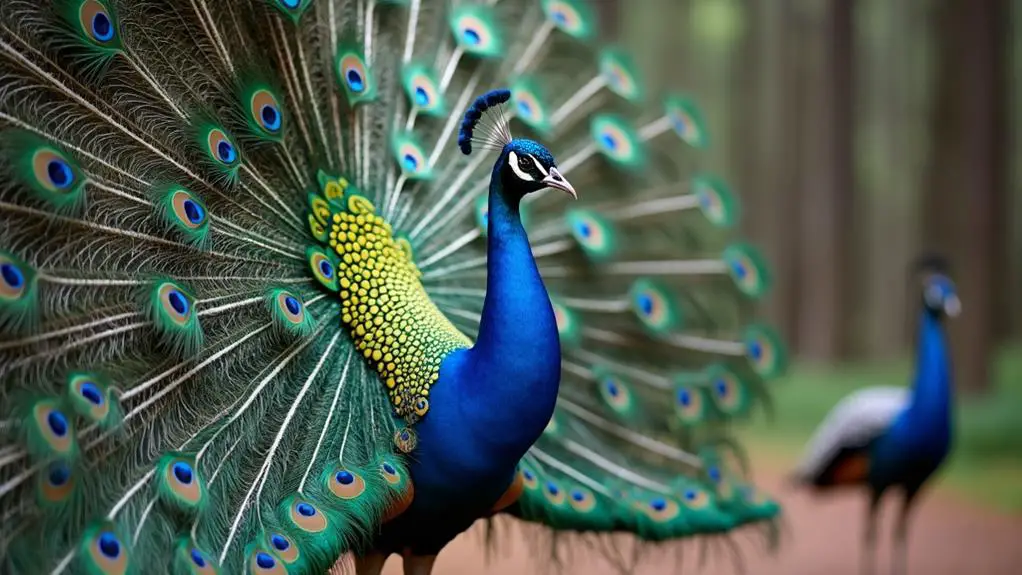
Evolution has instilled in peacocks an innate ability to perform the intricate courtship display you’ve just witnessed, and it’s this instinctual behavior that drives them to showcase their vibrant plumage.
This complex display is deeply rooted in the peacock’s genetic predisposition, which has been shaped over thousands of years through natural selection.
As a result of this evolutionary process, peacocks’ brain structure has developed to support this instinctual behavior.
Research has shown that the brain regions responsible for controlling courtship displays, such as the hypothalamus and the optic tectum, are highly specialized in peacocks.
Some key aspects of this instinctual behavior include:
- Developmental influences: Peacocks begin developing their courtship displays at a young age, suggesting that this behavior is influenced by a combination of genetic and environmental factors.
- Sensory inputs: Peacocks use visual and auditory cues to trigger their courtship displays, highlighting the importance of sensory inputs in driving this behavior.
- Motor patterns: The intricate movements involved in the courtship display are highly stereotyped, suggesting that they’re controlled by a complex system of motor patterns.
- Hormonal regulation: Hormones such as testosterone play a crucial role in regulating the peacock’s courtship display, highlighting the importance of hormonal influences on this behavior.
- Evolutionary conservation: The courtship display has been conserved across different species of peafowl, suggesting that it’s an evolutionarily important behavior.
Breeding Season Behaviors
During the breeding season, you’ll notice a significant increase in peacocks’ courtship displays, as they compete for mates and establish dominance.
This competitiveness serves a crucial purpose in determining social status within the flock. As peacocks spread their vibrant feathers, they’re signaling their strength, health, and genetic quality to potential mates and rivals.
As you observe peacocks during this time, you’ll notice that dominant males will engage in more frequent and intense displays, often targeting specific females or rival males.
This behavior helps maintain flock dynamics, with dominant peacocks defending their territory and mating rights. Subordinate males, on the other hand, may adopt more subtle courtship strategies or even mimic the displays of dominant males to increase their chances of mating.
FAQs: Why Peacocks Spread Their Feathers
Can Peacocks Spread Their Feathers in Cold Weather?
You’ll find that peacocks can still spread their feathers in cold weather, as they’ve developed winter adaptations to cope with cold climates, such as fluffing out their feathers to trap warm air next to their skin.
How Many Eyespots Do Peacocks Have on Their Feathers?
You’re examining the intricate patterns on a peacock’s feathers, noticing the feather symmetry and iridescence patterns. Each eye-catching feather displays an average of 150-170 eyespots, with some feathers showcasing up to 200 spots in perfect symmetry.
Can Female Peacocks Spread Their Feathers Like Males?
You notice female peacocks, though less flamboyant, can fan their feathers, albeit faintly, in mating rituals, showcasing subtle, shimmering shades. Female dominance isn’t typically demonstrated through this display, unlike males’ dazzling, elaborate spreads.
Are Peacocks’ Feathers Naturally Colored or Dyed?
You’ll discover peacocks’ feathers are naturally colored by microscopic crystal-like structures that refract light, not dyed. These color pigments, called melanosomes, produce the blues and greens, while carotenoids create the yellows and reds, offering safer dye alternatives.
Can Peacocks Spread Their Feathers When They’re Young?
Can you imagine witnessing a young peacock’s first majestic display? As you observe juvenile development, you’ll notice peacocks can spread their feathers at around 6 months old, preparing them for future mating rituals, though full plumage takes years to mature.
Conclusion
As you’ve witnessed the peacock’s majestic display, you’re left wondering: what triggers this spectacle? The answer lies in a delicate balance of instinct, evolution, and survival. But just as the peacock’s feathers unfold, so do the complexities of its behavior. Will it successfully attract a mate, defend its territory, or succumb to predators? The peacock’s fate hangs in the balance, as its feathers continue to whisper secrets of its ancient, primal language.

